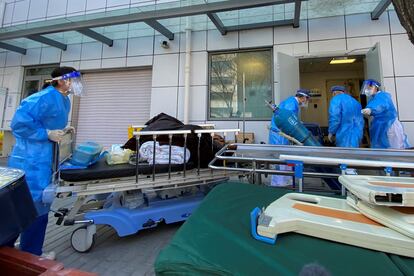China Covid surge: keys to the new wave that has the world on high alert
A lack of transparency over the scale of the latest outbreak and concerns over the possibility of new variants emerging have led to new restrictions in several countries

Border restrictions, meetings at the highest level, daily reports of millions of infections… the world had been optimistic that the end of 2023, the third year of the coronavirus pandemic, would signal a definitive return to normality. Events in China over the past few days, however, have brought issues that everybody believed were now overcome back to the fore, triggering fears of another setback in the global battle against the Covid-19 crisis.
Those fears are based on what is known about the latest surge in cases in China, but equally by what is not known. A lack of official data on the latest wave affecting the Asian giant has fueled mistrust in Beijing and sparked speculation. The repercussions it will have on the rest of the world is the big underlying question, but every forecast or calculation is hindered by the same problem: the scarcity of statistics and scant confidence in those that are available. These are the keys to the latest incarnation of the pandemic.
Why is the Chinese population so poorly protected against Covid-19?
China’s population is very poorly immunized against coronavirus for two main reasons. The first is that since the outset of the pandemic Beijing operated a strict zero-Covid policy, resorting to all possible means to prevent the spread of the virus. The result is that the population has scarcely been exposed to the pathogen and therefore natural immunity against the virus has not been widely developed. The second reason is that protection from vaccines is also low. Although over 90% of the population has had the first dose, only 69.8% of those aged over 60 have received the booster, a figure that drops to 42.4% in the over-80s. According to the 2020 census, 191 million people in China are aged over 65. The two vaccines in circulation in the country, Sinovac and Sinopharm, have also proven to be less effective than those used in other countries, such as Pfizer-BioNTech, Moderna and the Russia-developed Sputnik V. According to recent studies, the two Chinese vaccines are less than 80% effective, compared to over 90 percent for those used elsewhere in the world.
Why did China’s zero-Covid policy fail?
The Omicron variant, the fastest-spreading virus ever recorded, arrived in China about a year ago. The zero-Covid policy installed by Beijing had managed to keep previous strains of the virus at bay but as Omicron is so contagious, cases and outbreaks have been increasing, forcing the population to live in almost permanent confinement and undergo PCRs on an almost daily basis. Tension over the restrictions built up as the months went by until it exploded in the form of unprecedented social protests across the country: the government’s reaction was to backtrack on zero-Covid practically overnight.
Why has ending zero-Covid made matters so complicated?
China was not the only country to adopt zero-Covid measures: New Zealand, for example, locked down the entire country in August 2021 after a single case was detected. It is not uncommon for countries that have adopted stringent measures to experience a sudden surge in cases when these are relaxed, but this is usually carried out gradually and on the basis of the protection afforded by vaccines. In China, on the other hand, the decision was implemented suddenly on December 7, at a time when the incidence of infections was already on the rise. In other words, according to experts, under the worst possible conditions. “Such a large country, such a poorly protected population and a sudden withdrawal of almost all restrictions. It is something that in epidemiological terms we had never seen before,” says Quique Bassat, epidemiologist and Catalan Institution for Research and Advanced Studies researcher at the ISGlobal institute in Barcelona.

How many deaths are being reported in China?
It is impossible to calculate the magnitude of this latest wave. It is no longer mandatory to take PCR tests in China and the National Health Commission has said it will no longer provide daily statistical updates. In any case, central figures are open to question: officially, China has registered 5,246 Covid-related deaths since the beginning of the pandemic and a dozen since the end of Beijing’s zero-Covid policy on December 7. Last week, the Chinese authorities altered the methodology for counting Covid-related deaths, restricting these only to patients who have died from a primary cause of pneumonia or respiratory failure. According to Bloomberg, citing data handled by the Chinese health authorities, almost 250 million people were infected in the country in the first three weeks of the month with 37 million cases in just one day on December 20. British health data analysis organization Airfinity said Thursday that 9,000 people are likely to die every day in China due to the latest surge, twice as many as a week ago, according to its own estimates.
What will happen in China over the next few weeks?
All forecasts point to a huge wave of infections that will flood hospitals. International epidemiologists estimate that between one and two million people will die of Covid-related causes in China in 2023 and Chinese specialists predict there will be three major waves this winter: the current one will mainly affect the big cities, while the other two will reach rural areas due to travel during the Lunar New Year vacations, which take place between January 21 and 27. Another question is whether the healthcare system, which has already begun to feel the strain, will be able to cope. According to official figures, there are 138,100 intensive care units nationwide and the number of beds in these wards represents around 10 per 100,000 inhabitants.
Which other countries will be affected?
According to experts including Bassat, in addition to China countries with weaker public health systems are more likely to be adversely affected. “The situation is also worrying for countries with low vaccination coverage and where virus circulation is currently low, such as those in Africa. Furthermore, these are countries that have a close relationship with China and it is foreseeable that the increase in the incidence there will be transferred to them,” he notes.
Will new variants emerge?
Since the novel coronavirus was declared a pandemic by the World Health Organization, experts and health authorities have been gripped by fear of the emergence of new, more lethal and more contagious variants. While an explosion of cases makes the development of new mutations inevitable, it remains to be seen whether these are epidemiologically relevant. The Chinese authorities claim to be monitoring Omicron subvariants currently circulating in the country and have set up a database in which genetic sequences of the virus are shared weekly from samples taken from three hospitals in each province. Despite these efforts, misgivings persist. “We don’t know which variants are affecting the China. The first thing to do is to analyze what is happening and epidemiologically monitor the situation in the West. It would only be alarming if a new variant other than Omicron emerges. At the moment we don’t have any evidence of this but a policy of transparency is needed in China,” said María del Mar Tomás, spokesperson for the Spanish Society of Infectious Diseases and Clinical Microbiology, on Thursday.
How have other countries reacted to the surge in China?
Italy was one of the first countries to ask travelers from China for a negative diagnostic test. The decision was taken after half of the passengers on a flight arriving in Milan from China on December 26 tested positive. Japan, India, Malaysia, Taiwan and the United States have also decided to implement tighter restrictions, something that the European Union says it does see as necessary at the current time. “The coordination of national responses to serious cross-border threats to health is crucial,” the European Commission stated after a meeting of its Health Security Committee. For now, the EU will limit itself to active surveillance by means of genetic sequencing. Meanwhile, Italy reported that it has not detected any unknown variants in the samples tested from people arriving from China.
Sign up for our weekly newsletter to get more English-language news coverage from EL PAÍS USA Edition
Tu suscripción se está usando en otro dispositivo
¿Quieres añadir otro usuario a tu suscripción?
Si continúas leyendo en este dispositivo, no se podrá leer en el otro.
FlechaTu suscripción se está usando en otro dispositivo y solo puedes acceder a EL PAÍS desde un dispositivo a la vez.
Si quieres compartir tu cuenta, cambia tu suscripción a la modalidad Premium, así podrás añadir otro usuario. Cada uno accederá con su propia cuenta de email, lo que os permitirá personalizar vuestra experiencia en EL PAÍS.
¿Tienes una suscripción de empresa? Accede aquí para contratar más cuentas.
En el caso de no saber quién está usando tu cuenta, te recomendamos cambiar tu contraseña aquí.
Si decides continuar compartiendo tu cuenta, este mensaje se mostrará en tu dispositivo y en el de la otra persona que está usando tu cuenta de forma indefinida, afectando a tu experiencia de lectura. Puedes consultar aquí los términos y condiciones de la suscripción digital.
More information
Archived In
Últimas noticias
Welcome to the post-religion era: The idea of Christianity as the absolute truth has become obsolete
‘I thought you would like it’: The risky sexual practice popularized by TV shows and TikTok
The digitalization of tourism: ‘They promise experiences and gave us the worst possible one’
Mexican peso defies uncertainty with forecasts of a new period of stability in 2026
Most viewed
- Sinaloa Cartel war is taking its toll on Los Chapitos
- Reinhard Genzel, Nobel laureate in physics: ‘One-minute videos will never give you the truth’
- Oona Chaplin: ‘I told James Cameron that I was living in a treehouse and starting a permaculture project with a friend’
- Why the price of coffee has skyrocketed: from Brazilian plantations to specialty coffee houses
- Silver prices are going crazy: This is what’s fueling the rally










































